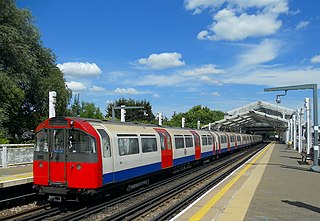Related Research Articles

The Docklands Light Railway (DLR) is an automated light metro system serving the redeveloped Docklands area of London, England. First opened on 31 August 1987, the DLR has been extended multiple times, giving a total route length of 38 km (24 mi). Lines now reach north to Stratford, south to Lewisham, west to Tower Gateway and Bank in the City of London financial district, and east to Beckton, London City Airport and Woolwich Arsenal. Further extensions are under consideration.

The London Underground is a rapid transit system serving Greater London and some parts of the adjacent counties of Buckinghamshire, Essex and Hertfordshire in England.

The Tube map is a schematic transport map of the lines, stations and services of the London Underground, known colloquially as "the Tube", hence the map's name. The first schematic Tube map was designed by Harry Beck in 1931. Since then, it has been expanded to include more of London's public transport systems, including the Docklands Light Railway, London Overground, the Elizabeth line, Tramlink, the London Cable Car and Thameslink.

Transport for London (TfL) is a local government body responsible for most of the transport network in London, United Kingdom.

The Bakerloo line is a London Underground line that goes from Harrow & Wealdstone in suburban north-west London to Elephant & Castle in south London, via the West End. Printed in brown on the Tube map, it serves 25 stations, 15 of which are underground, over 14.4 miles (23.2 km). It runs partly on the surface and partly in deep-level tube tunnels.

Waterloo is a London Underground station located beneath Waterloo National Rail station. As of 2020, it is the 5th busiest station on the London Underground, with 16.62 million users. It is served by four lines: the Bakerloo, Jubilee, Northern and Waterloo & City lines.

Baker Street is a London Underground station at the junction of Baker Street and the Marylebone Road in the City of Westminster. It is one of the original stations of the Metropolitan Railway (MR), the world's first underground railway, opened on 10 January 1863.

Brixton is a London Underground station on Brixton Road in Brixton in the London Borough of Lambeth, South London. The station is the southern terminus of the Victoria line. The station is known to have the largest London Underground roundel on the network. The next station is Stockwell.

Westminster is a London Underground station in the City of Westminster. It is served by the Circle, District and Jubilee lines. On the Circle and District lines, the station is between St James's Park and Embankment, and on the Jubilee line it is between Green Park and Waterloo. It is in Travelcard Zone 1. The station is located at the corner of Bridge Street and Victoria Embankment and is close to the Houses of Parliament, Westminster Abbey, Parliament Square, Whitehall, Westminster Bridge, and the London Eye. Also close by are Downing Street, the Cenotaph, Westminster Millennium Pier, the Treasury, the Foreign and Commonwealth Office, and the Supreme Court.

Old Street is a National Rail and London Underground station at the junction of Old Street and City Road in central London, England. The station is on the Bank branch of the Northern line between Moorgate and Angel stations and on the Northern City Line between Moorgate and Essex Road stations. The station is in the London Borough of Islington. It is in Travelcard Zone 1.

Barbican is a London Underground station situated near the Barbican Estate, on the edge of the ward of Farringdon Within, in the City of London in Central London. It has been known by various names since its opening in 1865, mostly in reference to the neighbouring ward of Aldersgate.

Henry Charles Beck was an English technical draughtsman who created the present London Underground Tube map in 1931. Beck drew the diagram in his spare time while working at the London Underground Signals Office. Although his design was initially rejected, the Publicity Office of London Transport changed their minds after Beck resubmitted an updated copy and the map was first issued a pocket edition in January 1933. It was immediately popular, and the Underground has used topological maps to illustrate the network ever since.

Mile End is a London Underground station in Mile End, London. It is served by the Hammersmith & City, District and Central lines. This station features a cross-platform interchange in both directions, District and Hammersmith & City lines stopping on the inside tracks and the Central line stopping on the outside tracks. It is in Travelcard Zone 2.

The London Underground 1973 Stock is a type of rolling stock used on the Piccadilly line of the London Underground. It was introduced into service in 1975 with the extension of the line to Hatton Cross, followed by a further extension to Heathrow Central in 1977. A total of 86 six-car trains were built.

The London Underground 1972 Stock is a type of rolling stock used on the London Underground. The 1972 Stock was ordered to make up the shortfall in trains on the Northern line's 1959 Tube Stock fleet; however it is nowadays used on the Bakerloo line. Following the withdrawal of the British Rail Class 483 EMUs in 2021, these trains are the oldest EMUs in passenger service in Britain. A total of 63 seven-car trains were built in two separate batches.

The London Underground S7 and S8 Stock, commonly referred to as S Stock, is a type of passenger train running on the London Underground's subsurface lines since 2010. Manufactured by Bombardier Transportation's Derby Litchurch Lane Works, the S Stock was ordered to replace the A60, A62, C69, C77 and D78 stock on the Metropolitan, District, Hammersmith & City, and Circle lines, which all dated from the 1960s and 1970s. The order was for a total of 192 trains, and consisted of two types, S7 Stock for the Circle, District and Hammersmith & City lines, and S8 Stock for the Metropolitan line, with differences in the arrangement of seating and number of cars. Both types have air-conditioning and low floors to ease accessibility for disabled people, and also have open gangways to allow passengers to move from one car to another whilst the train is moving.

London Overground is a suburban rail network serving London and its environs. Established in 2007 to take over Silverlink Metro routes, it now serves a large part of Greater London as well as the home county of Hertfordshire, with 113 stations on nine different routes.

Art on the Underground, previously called Platform for Art, is Transport for London's (TfL) contemporary public art programme. It commissions permanent and temporary artworks for London Underground, as well as commissioning artists to create covers for the Tube map, one of the largest public art commissions in the UK.

The Night Tube and London Overground Night Service, often referred to simply as Night Tube, is a service pattern on the London Underground ("Tube") and London Overground systems which provides through-the-night services on Friday and Saturday nights on the Central, Jubilee, Northern, Piccadilly, and Victoria lines, and a short section of the London Overground's East London line. The service began on the night of Friday 19 August 2016, providing 24-hour service on these routes from Friday morning to Sunday evening each weekend. It was suspended from Friday 20 March 2020 because of the COVID-19 pandemic, with the service partially reopening on Saturday 27 November 2021.

The Elizabeth line is a high-frequency hybrid commuter rail and rapid transit service in London and its suburbs. It runs services on dedicated infrastructure in central London between London Paddington and Abbey Wood; along the Great Western Main Line from London Paddington to Reading and Heathrow Airport in the west; and along the Great Eastern Main Line between Liverpool Street and Shenfield in the east. The service is named after Queen Elizabeth II, who officially opened the line on 17 May 2022 during her Platinum Jubilee year; passenger services started on 24 May 2022.
References
- ↑ "Transported by Design - Transport for London". Archived from the original on 17 April 2016. Retrieved 15 March 2016.
- ↑ "advertise". Global. Retrieved 12 August 2021.
- ↑ "Celebrate London's Transport Design Icons" (in Chinese (Hong Kong)). Retrieved 12 August 2021.
- ↑ "Vote Now For London's Best Transport Design Icon". Londonist. 2 September 2015. Retrieved 12 August 2021.
- ↑ Goldstein, Danielle. "Transported By Design: Vote for your favourite part of London transport". Time Out London. Retrieved 12 August 2021.
- ↑ London's transport 'Design Icons' announced London Transport Museum
- ↑ "Celebrate London's Transport Design Icons" (in Chinese (Hong Kong)). Retrieved 12 August 2021.
- ↑ "Black Cab tops the list of London's transport 'Design Icons'". The Drum. Retrieved 12 August 2021.
- ↑ "See Design Icons Of The London Underground". Londonist. 5 February 2016. Retrieved 12 August 2021.
- ↑ "London Transport Museum Opens New 'London By Design' Gallery". Londonist. 1 November 2015. Retrieved 12 August 2021.
- ↑ "Winter Wanders". Time Out London. Retrieved 12 August 2021.
- ↑ "London Underground launches new uniform from Wayne Hemingway". the Guardian. 3 November 2014. Retrieved 12 August 2021.
- ↑ Dubuis, Anna (29 May 2015). "TfL uniform redesign unveiled in first update for 10 years". www.standard.co.uk. Retrieved 12 August 2021.
- ↑ "Regent Street London". www.regentstreetonline.com. Retrieved 12 August 2021.
- ↑ "TfL announces plans for Regent Street design festival". www.campaignlive.co.uk. Retrieved 12 August 2021.
- ↑ "Transported by Design - Transport for London". Archived from the original on 17 April 2016. Retrieved 15 March 2016.
- ↑ "advertise". Global. Retrieved 12 August 2021.